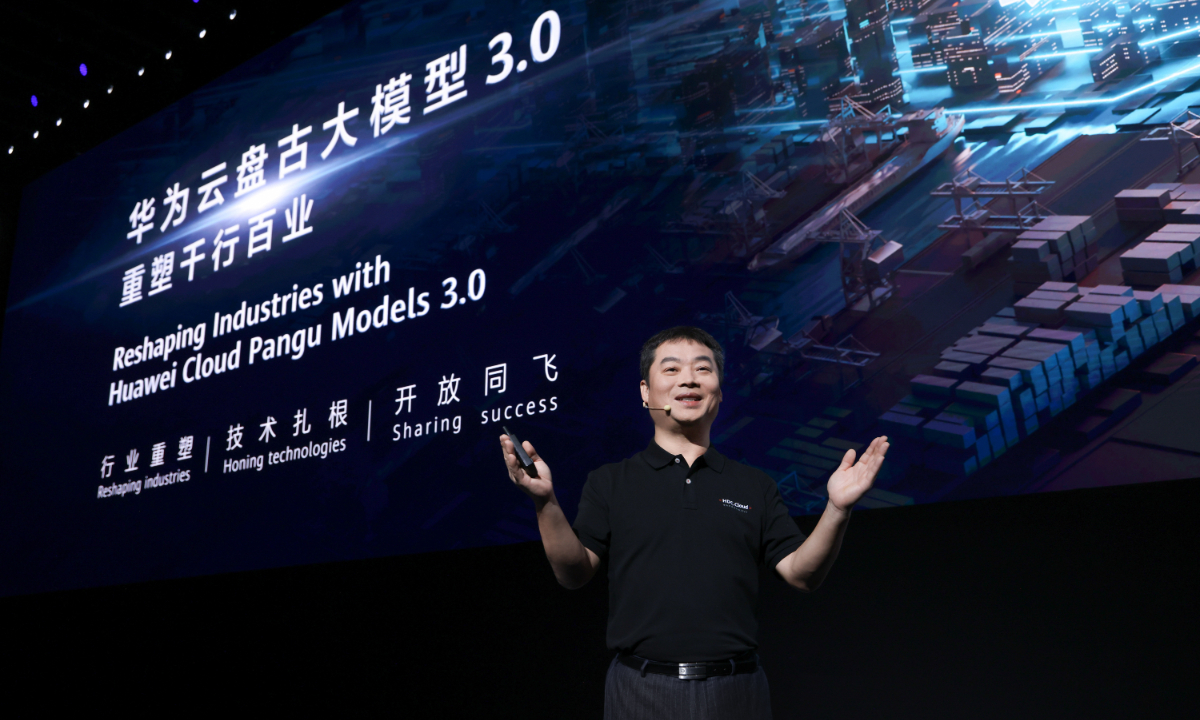
Zhang Pingan, executive director of Huawei and CEO of Huawei Cloud. Photo: Courtesy of Huawei
Chinese tech giant Huawei has launched a new AI model Pangu 3.0 during the Huawei Developer Conference 2023 on Friday, marking a fresh update of its self-developed large language model amid a global frenzy in ChatGPT rush - which is believed to be the latest frontier of AI race between China and the US.
Large language models are the technology that underpins chatbots like ChatGPT. Huawei defines model of 3.0 as an industry-oriented series of large-scale models consisting of a "5+N+X" three-tier architecture. The L0 layer comprises five foundational large-scale models in natural language processing, computer vision, multimodal learning, prediction and scientific computing.
It also offers a range of serialized foundational large-scale models with parameter counts of 10 billion, 38 billion, 71 billion, and 100 billion, providing flexibility for customers to match their specific industry requirements in terms of scenario, latency, and response speed.
Rather than being good at activities such as "writing poems" like other GPT-like models, Pangu will primarily focus on "empowering and reshaping various industries," Zhang Pingan, executive director of Huawei and CEO of Huawei Cloud, said in a keynote speech in South China's Dongguan, the headquarters of the tech giant.
The Pangu model has been proven to "provide significant value" in various industries, including finance, manufacturing, pharmaceutical research and development, coal mining, and railway sectors, Zhang said.
The name Pangu comes from ancient Chinese mythology and folklore. Pangu is known as a legendary figure associated with the creation of the world.
One of a latest successful application of the model is in weather forecast. The breakthrough of Pangu weather AI model was published by Nature on Wednesday, one of the world's top scientific journals.
According to Huawei, Pangu-Weather is the first AI prediction model to demonstrate higher precision than traditional numerical weather forecast methods. The model allows a 10,000x improvement in prediction speed, reducing global weather prediction time to just seconds.
The company also demonstrated a real-time performance of the model in scenarios such as government affairs. In collaboration with the Futian district government in Shenzhen, South China's Guangdong Province, the company has launched Xiao Fu, a smart government assistant powered by the Pangu government affairs large-scale model.
The model has been finely tuned using over 200,000 government data points, including the 12345 government hotline, policy documents, and government encyclopedias, allowing it to possess a wealth of industry knowledge regarding laws, regulations, and administrative procedures, You Peng, director of Huawei Cloud EI Service Product Department, told the event on Friday.
In the past several months, a slew of Chinese entities has announced they are developing their own large language models as the GPT craze is spreading across the globe. These include firms such as Alibaba, Tencent and Baidu, as well as universities and state-backed institutions.
And the GPT craze is now believed to be the latest frontier of a technology rival between China and the US.
On Friday, Huawei, and companies including 360, Baidu, and Alibaba were appointed by the China Electronics Technology Standardization Institute under the Ministry of Industry and Information Technology as the leading organizations for the National Artificial Intelligence Standardization General Group on Large-scale Models.
This appointment aims to actively promote the establishment of a national standard system for large-scale models.
To restrict China's access to crucial technology, the US is planning to restrict China's access to US cloud-computing services, a restriction aiming at closing a crucial loophole in the export controls the US implemented in October that allowed Chinese AI firms to access high-end chips through the cloud, the Wall Street Journal reported on July 4.




